Kore (sculpture)
Kore (Greek: κόρη "maiden"; plural korai) is the name given to a type of free-standing ancient Greek sculpture of the Archaic period depicting female figures, always of a young age.
Kouroi are the youthful male equivalent of Kore statues. They both show the restrained "archaic smile", but — unlike the nude kouroi — korai are depicted in thick drapery, ornate and (in painted examples) very colorful and often have elaborate braided hairstyles.
There are multiple theories on who they represent, and as to whether they represent mortals or deities. One theory is that they represent Persephone, the daughter in the triad of the Mother Goddess cults or votary figures to attend the maiden goddess.


They also often have a much more relaxed and natural posture, sometimes with an extended arm. Some, but perhaps not all, korai were painted, with colorful drapery and their skin possessing a natural coloring.
Athenian tradition
Such statues existed in many cities of Greece, but most important are the fourteen statues making up the Korai of the Acropolis of Athens that were found east of the Parthenon in 1886. These statues were set particularly on round bases and were outdoor-exposed. When the Persians burned the Acropolis in 480 BC, they threw them from their bases, but some survived, and are hosted now in the Acropolis Museum. Some of them represented priestesses, while others were more simple, represented female figures and were dedicated to the goddess Athena. They have smiling faces, complicated hairdressing and island-type dressing, Ionic style, their left hands holding their chiton while their right hands are holding a flower, fruit or bird. Their hair, along with some other characteristics and the folds of their clothing, were colored.
Dominant color was the red for the lips and hair, red and blue for the clothes, and black for the eyes. The kores wore many colored jewels, indicating the brightness of their dressing. Thus they symbolized the elegant, dressy Athenian of the 6th century BC.
Examples of korai
The most beautiful of the korai of the Acropolis, the Antenor Kore, is simpler with a more serious appearance than the others and thus was more suited to the masculine character of Athena, to whom she was also dedicated. She was made by Antenor, an Athenian creator, in the late 6th century BC, and was a votive of a potter named Nearchos. But there were not only the korai used as offerings. There were also the famous caryatids of the 5th century BC, who were used as architectural supports, the Tanagraean korai, etc. There is also the famous kore of Antion, which was found in Italy, and is an original work of the 4th century BC, created by the sculptor Phanis, student of Lysippos. The Phrasikleia Kore (Attica, mid-6th century BC) is one of the best-preserved works of Archaic Greek sculpture.
The Peplos Kore (right) dates from 530-520 BC. It was found in Athens and is in the collection of the Acropolis Museum in Athens. Some argue that this statue represents the goddess Athene. Another well-known example of a Kore statue is the Lady of Auxerre at the Louvre, though this is from the Daedalic style of Cretan art and not typical of the kore type as a whole.
Examples with articles
- Lady of Auxerre, Minoan, Louvre
- Korai of the Acropolis of Athens, 570 to 480 BC, mostly Athens
- Phrasikleia Kore, 550-540 BC, Athens
- Kore of Lyons, 540s BC, Lyon
- Peplos Kore, 530-520 BC, Athens
- Antenor Kore, 530-20 BC, Athens
Bibliography
- G.M.A. Richter, Korai. Archaic Greek Maidens, a Study of the Development of the Kore Type in Greek Sculpture, 1968.
- Eleanor Guralnick, Proportions of Korai, American Journal of Archaeology, Vol. 85, No. 3 (Jul., 1981), pp. 269–280.
- C.M. Keesling, Votive Statues of the Athenian Acropolis. Cambridge: Cambridge University Press, 2003.
- M.C. Stieber, The Poetics of Appearance in the Attic Korai. Austin: The University of Texas Press, 2004.
- Katerina Karakasi, Archaic Korai, 2004.
- Jürgen Franssen, Votiv und Repräsentation. Statuarische Weihungen archaischer Zeit aus Samos und Attika. Heidelberg: Verlag Archäologie und Geschichte, 2011. ISBN 978-3-935289-36-8
External links
| Wikimedia Commons has media related to Kore (sculpture). |
- 3D model of Acropolis Kore 678 via laser scan of a plaster cast of Acropolis Museum's Kore 678
- Korai — Ancient-Greece.org
- Gallery — Mlahanas.de
- The Kore collection from the new museum of Acropolis — Greek-thesaurus
- Stiftung Archäologie Reconstruction - Polychromy